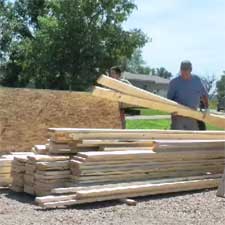Hart and Home YouTube – Episode III
If you missed our previous episodes, please go to bottom of this article, on left, and click on arrow twice to go to Hart and Home YouTube – Episode I. Moving forward:
For those following along at home:
 Some discussion will be made here about “allowable defects” in lumber. Our main struggle with lumber quality is clients having unrealistic expectations. Lumber is chosen for strength characteristics, rather than due to “pretty looks”. If an expectation lumber will be clear, vertical grain, knot and wane-free, a severe disappointment will occur. Wood is an organic material. While produced in a “factory” environment (a sawmill), lumber is subjected to naturally occurring defects accounted for in grading rules. These characteristics are taken into account in strength values for allowable design. Minor dimensional differences in individual boards are a function of shrinkage due to moisture content, wood species and even individual tree characteristics. Shrinkage is more prominent across grain – hence variations in the board’s wide face are more pronounced. Ultimately these small dimensional differences do not affect the finished building.
Some discussion will be made here about “allowable defects” in lumber. Our main struggle with lumber quality is clients having unrealistic expectations. Lumber is chosen for strength characteristics, rather than due to “pretty looks”. If an expectation lumber will be clear, vertical grain, knot and wane-free, a severe disappointment will occur. Wood is an organic material. While produced in a “factory” environment (a sawmill), lumber is subjected to naturally occurring defects accounted for in grading rules. These characteristics are taken into account in strength values for allowable design. Minor dimensional differences in individual boards are a function of shrinkage due to moisture content, wood species and even individual tree characteristics. Shrinkage is more prominent across grain – hence variations in the board’s wide face are more pronounced. Ultimately these small dimensional differences do not affect the finished building.
All structural dimensional framing lumber used in Hansen Buildings will be at least graded as #2 (or “standard”) or better. For discussion’s sake, we will limit scope to this grade. Four inch and smaller (e.g. 4×6 and any two inch – 2×4 through 2×12, 4×4 and 4×6), are all graded under “joists and planks” rules. Characteristics listed below are unintended to be all-inclusive, but merely to be a frequently seen item overview.
In any given lumber “production run” typically 5% is allowed to be outside grading rules (to have more defects than expressly allowed) and still have a sum total declared as “on grade”.
Checks – seasoning checks are unlimited. Through checks at ends are limited as splits. Splits can be equal to 1-1/2 times board face width (e.g. 8-1/4” on a 2×6, 16-7/8” on a 2×12). Keep in mind, many times these boards will be trimmed off, especially when used as girts, purlins or rafters. A split portion may thus be removed when trimmed to be put into service.
Knots – on a 2×6, up to 1-7/8” at wide face edge, 2-7/8” at wide face centerline; on a 2×12 up to 3-3/4” at wide face edge, 4-3/4” at wide face centerline.
Holes – (from any cause) on a 2×6 1-1/2”; on a 2×12, 3”.
Wane – up to 2/3 thickness and 1/2 width for 1/4 length. An example would be on a 12’ long 2×6, wane could be 2-3/4” on wide face, 1” in depth across 1-1/2” face and 3’ in length.
Bow (or Crook) – a board size and length function. As an example: for a 2x6x12’ – 5/8” would be acceptable, with greater amounts allowable with longer lengths.
Twist – for a 4x6x16’ would be allowable up to 1-1/2” and still be within grade.
Timbers
5” x 5” and larger are graded as “Posts and Timbers” and have their own characteristics. Again, addressing #2 grade, they include:
End splits – up to twice post face are permitted: (Ex: 12” on a 6” face.)
Wane – 1/3 of face.
Bow, crook and twist are NOT limiting factors under grading rules for posts and timbers.
It is essential any suspected shortage or damage be reported immediately. Vendors become highly suspicious of possible jobsite damage, as it increases with time. An example of this is when (after several months on a jobsite) a client asked for replacement of some damaged steel – his provided photographs actually showed tire marks where it had been run over!
Construction Manual – we do frequent updates and additions to it, often several times annually. Since Kevin and Whitney’s investment, more and more of our clients have gone to wet-set brackets, rather than embedded columns. Hence, we have added several pages of wet-set bracket specific details and instructions to Chapter 5, Setting Columns.
Solid sawn vs. glulam columns. We agree totally with Kevin’s analysis, glulams are a superior product and I would highly recommend them to any client (for extended reading, please see https://hansenpolebuildings.com/2014/10/glulam-4/). One downside is distribution, as they are manufactured in limited and highly scattered locations, costs of shipping and time delays can become issues.
Watch for our final episode of this series – coming soon!






